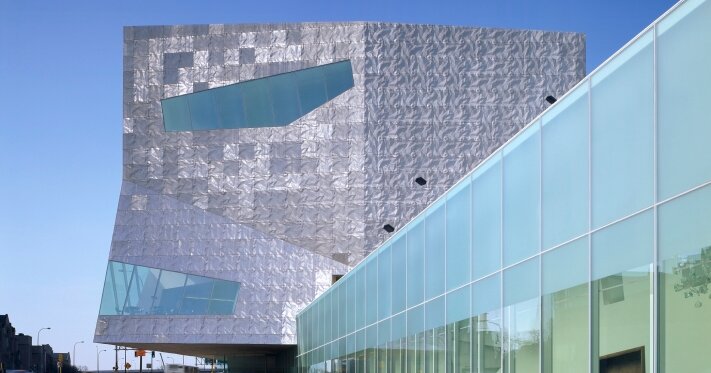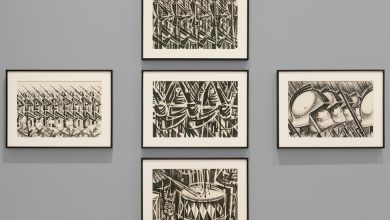This Time, Herzog & de Meuron Are Inside the Museum

In its early years, the architecture firm that Jacques Herzog and Pierre de Meuron founded in 1978 in Basel, Switzerland, was known for buildings that expressed personality through their exterior skins. Each design became a kind of essay on the architectural possibilities of a single material. There were the fiber-cement panels of the 1987 Ricola storage facility in Laufen, Switzerland, and the gabion walls, filled with stones, of the Dominus winery in the Napa Valley, completed a decade later.
By the time the pair collaborated with the Chinese artist Ai Weiwei on the Beijing National Stadium for the 2008 Olympics, known as the “bird’s nest” for its intricate facade of steel beams, they had become a pre-eminent example of the new breed of globe-hopping celebrity architects, alongside Frank Gehry, Rem Koolhaas and Zaha Hadid. Today, their office has more than 550 employees and has completed a number of high-profile U.S. projects, including museum buildings in San Francisco, Miami and Minneapolis, and the Powerhouse Arts Complex, in Brooklyn.
Herzog and de Meuron were born the same year, 1950, and met at age 7 before studying architecture together in Zurich. Playing a voluble Penn to de Meuron’s generally silent Teller, Herzog has long served as the firm’s public face. Ahead of a major exhibition on Herzog & de Meuron’s work, opening July 14 at the Royal Academy of Arts, in London, Herzog slipped out of the opening festivities at the Venice Architecture Biennale, in May, to sit down at the bar inside the Hotel Monaco, on the Grand Canal, for a wide-ranging conversation.
Sipping black tea, he discussed the upcoming Royal Academy exhibition — which focuses, in part, on the firm’s designs for hospitals and rehabilitation facilities, going back to a brain and spinal injury clinic in Basel that opened in 2002 — as well as the risks of working in autocratic countries and why he prefers to spend his time on Herzog & de Meuron’s smallest-scale projects. The conversation has been edited for clarity and condensed.
The conventional wisdom about architecture exhibitions is that they are a kind of a pale reflection of the real thing: You can’t squeeze a building inside a museum gallery. I wanted to start by turning that question around, what is it that you can do with an exhibition?
We give project numbers to each of our building projects. This is also true with exhibitions. And that’s part of the answer: It needs to be a project on its own terms. In our earliest exhibitions, we tested different forms, for example, by asking different photographers to take pictures of the same building of ours.
In London, we again found a different format. We have been offered three galleries. Each one will have a completely different mise-en-scène, a totally different design, different color.
The advance materials for the exhibition say that it was “curated in close collaboration” with your office and describe Herzog & de Meuron as “one of the most revered architecture firms in the world.” Is there any danger in being too involved, to the extent that there is a lack of curatorial or critical distance, or that the whole thing begins to feel like a marketing exercise?
Actually, the reason we curate the shows ourselves is not because we want to control how people think, but quite the opposite. I don’t want to be too defensive. I’m not a moralist. If I would to try to control everything, I would have chosen the wrong job.
The most egregious example of this dynamic I can recall was when the Guggenheim staged a Frank Gehry retrospective in 2001, in collaboration with Gehry’s office, at the same time the museum was working to win city approval for a giant new branch by Gehry in Lower Manhattan.
I do not have any political reasons why I would want the show this way, or that way. I think it’s important that people get a totally different idea on what we are working on. And that’s what this exhibition is about. It has a focus on health care, because that is something in our work that has never really been presented. And having done the Rehab clinic 20 years ago — which is one of our best projects, ever — it has been under the radar. We have done three other hospitals based on its success, in terms of how doctors, how patients, speak about it.
There’s certainly a consensus among the general public that the design of hospitals and health care facilities is among the worst …
It’s the worst!
Why do you think that is?
Because it’s been neglected by architects. Hospitals are even worse than prisons. And as soon as people look at it, it has a chance to be better. I’m sure that hospital architecture will be a big thing in the next 10, 20 years.
Some architects, particularly younger ones, are beginning to make the case that virtually any new construction is suspect from a climate point of view. You have certainly done plenty of work on reimagining existing buildings. Do you think there will be an increasing emphasis on this in your office, as opposed to ground-up construction?
It all depends on the legal conditions. Do they ask for this? Then the client or developer has to follow that guideline. I, as an architect, cannot push it. As an argument, I find it interesting. Some architects believe in the — how do you say, if there is nothing there …
Tabula rasa.
Exactly. Tabula rasa. I think it’s interesting to think, in a more serious way: What can I actually reuse? We may not like something that is there in an existing building, because it’s dated. But when you wait another 10 years, people start to like it again.
How do you decide, as an office, which projects to take on and which projects to decline? We’ve increasingly focused on this question over the last two years, especially since the war in Ukraine started. We had to give up a substantial amount of work in Russia, which was very painful — not economically but in other ways. As an architect, you do not deliver something like a merchant does. You build relationships with people. And we have had friendly relationships with interesting people in Russia.
After the war started, we canceled all contracts there. We have stopped all these activities. And what will happen in China? What will happen in Arab countries? We have not accepted various projects in different countries, because we were not sure about the relationship between the West and these countries. You’re tempted as an architect to accept things sometimes, especially in difficult countries, because there is less criticism, because there is more money, because there is more ambition.
You’ve completed a series of critically well-received projects in the United States. Collectively, those are an exception to the idea that European architects, and maybe Swiss architects in particular, have trouble in the U.S., because there’s not the same kind of attention to detail and rigor in construction. How have you approached the challenges of building in the United States?
We have a new project that is perhaps my favorite at the moment: Calder Gardens, in Philadelphia. It’s a new platform to show [the sculptor Alexander] Calder’s work in a totally different way. We have high expectations for its materiality. We want to create a rock that is artificial, but mimicking nature. We look at how far we can go with what the local builders can offer, without being insanely expensive.
In California, the Dominus winery is a good example. One of our top five, I think. We invented this kind of rock wall. And if you go back now, it still looks amazing. Could we have known that? We were young architects. It could have been a disaster, falling apart.
You have five senior partners in the office now. I’m curious about the role different partners play in each project.
The good thing about being an architect is that, if you stay healthy, you can work until you’re very old. I’m involved still in every project. Some, like Calder, I do almost everything: every single detail, every small thing. That’s certainly not the case in larger projects. A huge project may involve me less than a small project. It’s absurd, and a paradox, but it keeps me going. And Pierre and I work well together because we are so different.
How so?
Pierre has always organized the business, going back to when we were starting out. But it’s not fair to say that Pierre is the business guy and I’m the artist. Ideally, we look into projects together and we discuss things with the partners. We’ve reached a size which is good, because it also gives us some freedom, strangely enough. It’s not true that when you have a small office you have more freedom.
Is there an upper limit to the size of the office, a number above which you wouldn’t want to go?
If you grow more, then you have to give partners more independence, and then you have the New York office, the Hong Kong office — and I think they can be competing entities. That’s not the case for us.
Is there a building type you’d like to try that you haven’t done?
I’m working on a little chapel. It’s called “Autobahnkirche,” because it’s near the highway. It’s in the Swiss mountains, in a remote area. I’m not very religious, but this, together with the Calder, is my tiniest and most beloved project.
Herzog & de Meuron
July 14 through Oct. 15 at the Royal Academy of Arts, in London; royalacademy.org.uk.





